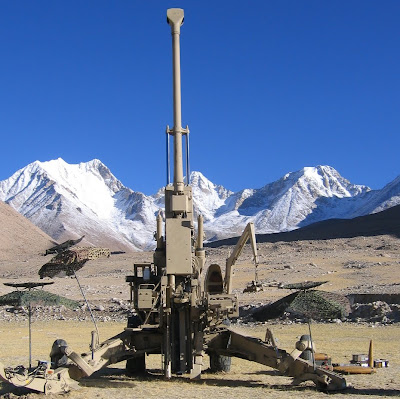IND151
BANNED

- Joined
- Oct 25, 2010
- Messages
- 10,170
- Reaction score
- 3
- Country
- Location

The defence ministry (MoD) will spend an unprecedented Rs 15,000 crore on the Ordnance Factory Board (OFB), its fully owned conglomerate of 41 factories that manufactures arms, ammunition, vehicles and equipment mainly for the military. This amount will be spent during the 12th Plan (2012-13 to 2016-17) on upgrading, modernizing and supplementing the OFB’s production facilities.
During the last decade, the OFB has spent an average of about Rs 400 crore per year on modernization. Now, during the 12th Plan, OFB modernisation will consume more than Rs 3,000 crore annually.
For private sector companies that are foraying into defence manufacture, this is worrying news. Bharat Forge, for example, has invested about Rs 100 crore on importing an entire factory to build artillery guns; it has set up a production unit in Pune. Now the private sector fears that that heavy expenditure on upgrading the OFB will result in military orders being placed on the OFB rather than on the private sector.
Dismissing such apprehension, a top MoD official tells Business Standard that the OFB’s modernization plan will not create additional production capacity. Instead, the new infrastructure is intended to improve production quality and to reduce the OFB’s manpower levels by increasing automation.
For example, some OFB facilities still fill explosive into ammunition by pouring it manually, a laborious and inaccurate process that causes variations in the ammunition. The new machines being installed will fill explosive using a screw-driven mechanism that is faster and more precise.
A key benefit of modernization will be a reduction in the OFB’s bloated workforce. While the OFB is authorized more than 1,50,000 workers, it functions with just 90,000 today. Modernization could bring this down to below 50,000.
This modernization plan comes as a major relief for the OFB, which has been tarred by scandal since the Central Bureau of Investigation arrested the OFB’s just-retired chairman Sudipta Ghosh on May 19, 2009 for allegedly accepting bribes from foreign companies.
Now dust from that scandal appears to be settling. While Ghosh has not yet been convicted, the MoD banned six arms vendors on Mar 05, 2012, from doing business with the OFB for ten years. Last month the army placed a Rs 1,260 crore order for 114 artillery guns, which the OFB has developed from plans obtained from Bofors in the 1980s. While Bofors provided 155 millimetre/39 calibre guns in the 1980s, the OFB has upgraded these with in-house R&D to 45 calibre.
Of the sanctioned Rs 15,000 crore, the OFB says that Rs 7,600 crore will be spent from the Replacement Fund on replacing old machinery with new, automated and efficient machines that require fewer operators. The Replacement Fund is built up from the depreciation amount that the OFB writes off each year, creating a corpus for replacing production machines after about 20 years of operation.
Another Rs 7,400 will be spent from the New Capital head on civil works and modern production gear that is badly needed in the OFB’s more decrepit factories. One of the OFB’s facilities, the Gun and Shell Factory, Cossipore, has produced equipment at the same location since 1802.
The New Capital expenditure also caters for new projects, such as the Rs 1,500 crore plan that was approved last month for manufacturing the DRDO-designed Pinaka multi-barrel rocket launcher, and advanced variants of its ammunition in several OFB facilities. In addition, the OFB will now build 51 mm and 81 mm mortar casings and will enhance its capacities for producing and overhauling infantry combat vehicles (ICVs).
“The modernisation plan, which was drawn up in 2010, has been approved by the government. Now the MoD will allocate funds to the OFB based on an annual expenditure plan,” says L Mohanty, the OFB’s Deputy Director (Engineering).
OFB officials admit that it will be a challenge to transparently absorb such a large modernization budget. Mohanty explains that the OFB has overhauled and simplified its procurement procedures, especially eProcurement, which is now mandatory for most transactions. Three key procurement manuals have been completely revamped. These include the Plant and Machinery Procurement Manual, with new procedures for overhauling machinery; the Civil Works Procedure Manual which has a simplified procedure for civil works construction; and the OFB Procurement Manual, which lays down the procedure for procuring raw materials.
The OFB was the world’s 46th largest arms manufacturer in 2010, according to the Stockholm International Peace Research Institute (SIPRI). Its total sales that year were Rs 11,214 crore ($2.04 billion), with arms sales bringing in about 80 percent of its revenue. However worker productivity has been abysmally low, at just Rs 12.5 lakhs per annum.
OFB performance
(Rs crore)
| Earnings | Earnings Growth | Profit | Exports | R&D spend | ||
| 2007-08 | 6,937.81 | 12.5 % | 590.01 | 27.44 | N.A. | 364.23 |
| 2008-09 | 7,229.31 | 4.19 % | 297.65 | 41.07 | 29.21 | 627.23 |
| 2009-10 | 8,715.25 | 15.99 % | 477.90 | 12.29 | 32.08 | 492.61 |
| 2010-11 | 11,214 | 28.60 % | 1,171.7 | 35.70 | 39.95 | 702.69 |
Modernization
Broadsword: MoD’s massive Rs 15,000 cr upgrade for ordnance factories











